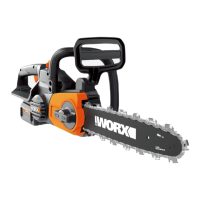11
incorrect operating procedures or conditions
and can be avoided by taking proper
precautions as given below:
- Maintain a firm grip, with thumbs
and fingers encircling the chain saw
handles, with both hands on the saw
and position your body and arm to
allow you to resist kickback forces.
Kickback forces can be controlled by the
operator, if proper precautions are taken.
Do not let go of the chain saw.
- Do not overreach and do not cut
above shoulder height. This helps
prevent unintended tip contact and
enables better control of the chain saw in
unexpected situations.
- Only use replacement bars and
chains specified by the manufacturer.
Incorrect replacement bars and chains may
cause chain breakage and/or kickback.
- Follow the manufacturer’s sharpening
and maintenance instructions for the
saw chain. Decreasing the depth gauge
height can lead to increased kickback.
GENERAL SAFETY WARNINGS FOR
BATTERY PACK
1) WARNING: Risk of fire and burns. Do
not disassemble, heat above 100°C
(212°F), or incinerate. Do not expose
cells or batteries to heat or fire. Avoid
storage in direct sunlight.
2) Dispose of used battery promptly. When
disposing of secondary cells or batteries,
keep cells or batteries of different
electrochemical systems separate from
each other.
3) Keep battery out of reach of children and in
original package until ready to use.
4) Never put batteries in mouth. If swallowed,
contact your physician or local poison
control center.
5) CAUTION – The battery used in this
device may present a risk of fire or
chemical burn if mistreated. Replace
battery with WORX only. Use of another
battery may present a risk of fire or
explosion.
6) WARNING: Do not use a visibly
damaged battery pack or appliance as
applicable.
7) WARNING: Do not modify or attempt
to repair the appliance or the battery
pack as applicable.
8) BATTERY MUST BE RECYCLED.
9) Do not short-circuit a cell or battery. Do
not store cells or batteries haphazardly in
a box or drawer where they may short-
circuit each other or be short-circuited by
conductive materials.
10)Do not subject cells or batteries to
mechanical shock.
11)Keep cells and batteries clean and dry. Wipe
the cell or battery terminals with a clean
dry cloth if they become dirty.
12)Do not maintain secondary cells and
batteries on charge when not in use.
13)Retain the original cell and battery
literature for future reference.
14)Do not use any charger other than that
specifically provided for use with the
equipment. Secondary cells and batteries
need to be charged before use. Always
use the correct charger and refer to the
manufacturer’s instructions or equipment
manual for proper charging instructions.
15) When possible, remove the battery from
the equipment when not in use.
16) Prevent unintentional starting. Ensure
the switch is in the off-position before
connecting to battery pack, picking up
or carrying the appliance. Carrying the
appliance with your finger on the switch or
energizing appliance that have the switch
on invites accidents.
17) Disconnect the battery pack from the
appliance before making any adjustments,
changing accessories, or storing appliance.
Such preventive safety measures
reduce the risk of starting the appliance
accidentally.
18) Under abusive conditions, liquid may be
ejected from the battery; avoid contact.
If contact accidentally occurs, flush with
water. If liquid contacts eyes, additionally
seek medical help. Liquid ejected from the
battery may cause irritation or burns.
19) Have servicing performed by a qualified
repair person using only identical
replacement parts. This will ensure that the
safety of the product is maintained.

